Dodge Challenger SRT Demon Design Explained by Mark Trostle

Mark Trostle, head of Dodge and SRT design, explains the ins and outs of the 2018 Dodge Challenger SRT Demon’s unique exterior.
Since the 2018 Dodge Challenger SRT Demon made its grand debut on the eve of the 2017 New York International Auto Show, there have been many questions raised about the unique styling cues. Why does the Demon have those flares? Why don’t the skinny front-runner race wheels extend out farther to the edges of the wheel openings? Why doesn’t the car have hood pins? What has been done to reinforce the hood to handle the increased pressure with the huge Air Grabber scoop?
Those were the most prevalent questions from readers around the internet, but there were plenty more inquiries about why the new Dodge Demon looks the way that it does. Fortunately, when speaking with Dodge and SRT design boss Mark Trostle, we were able to get answers to all of the most common questions on the world’s quickest production car.
Why the Flares?
The most noticeable and perhaps the most controversial design aspect of the 2018 Dodge Challenger SRT Demon is the flared wheel openings. Each wheel opening is trimmed with a 47mm flare constructed from the same composite material as the front and rear fascia, allowing plenty of room for the 315 Nitto drag radials to move around. However, plenty of current Hellcat Challenger owners insist that, even without flares, they have no problem running 315 tires all around.
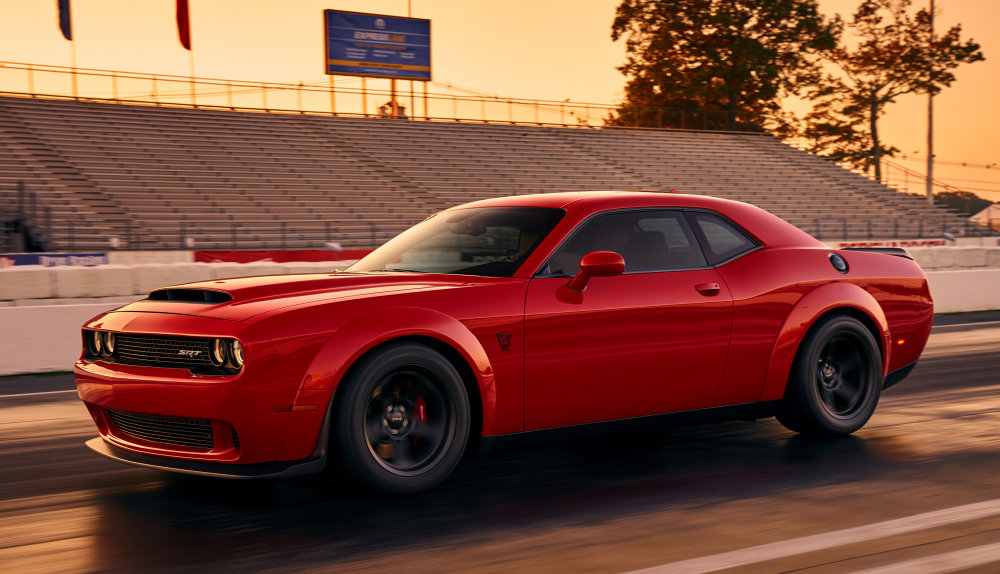
What is being missed here is that there is a difference between a private owner mounting wider tires on their Challenger, and Dodge mounting wider tires on the Demon from the factory. To a private owner, so long as the tires don’t stick way out of the fenders when the car is at rest, it is “safe enough” for public road use. In some areas, tires that stick way out of the wheel openings will get a driver pulled over and fined, so most owners will insist that if tires don’t hang out when the car is parked, it is fine for road use. On the other hand, automakers have requirements to meet in terms of the distance from the tire edge to the fender edge. For the automaker, it isn’t as simple as the tires “not hanging out”. Designers have to meet both internet measurement requirements and those offered by the government safety folks.
Next, Mark Trostle spoke a bit about the complete design of the 2018 Demon wheel flare. There is a misconception that the Demon flares are simply your run-of-the-mill fiberglass “truck flares” bolted up to the fenders of the Hellcat Challenger, but that is not the case by any stretch.
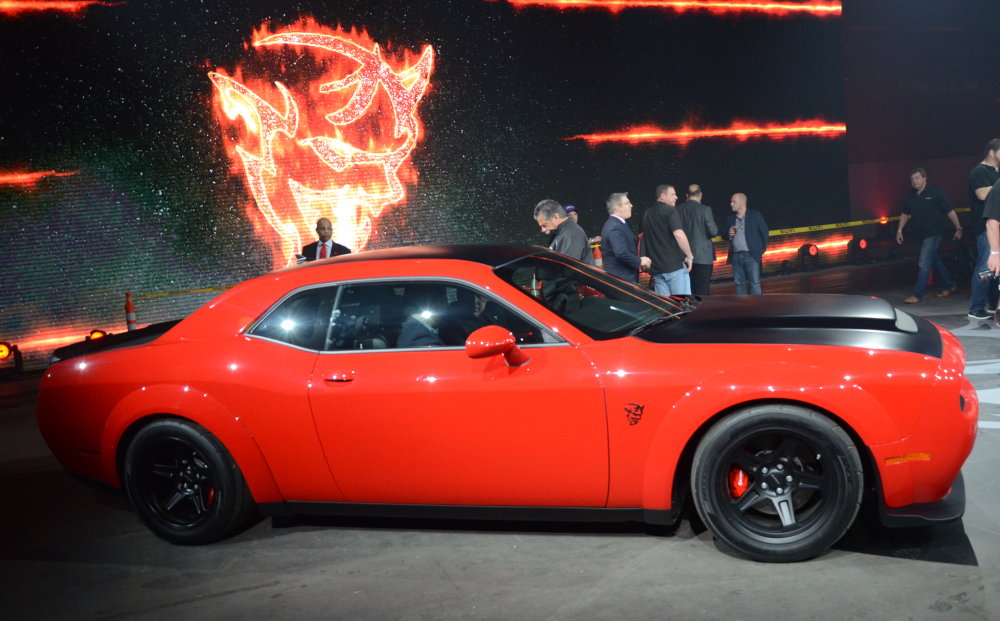
First, the flares are not fiberglass, they are TPO (thermoplastic olefins), the same material used for the front and rear fascia of the Challenger and many other modern vehicles. This material is designed to withstand vibration, temperature changes and abuse just like the rest of the composite exterior bits.
Second, the Demon flares are not simply bolted up to the standard Dodge Challenger fenders. The front fenders and rear quarter panels of the new Demon all have unique wheel opening shapes, allowing for additional clearance around the wide drag radial tires. Basically, if you remove the flares from a production Demon, you won’t find a nice, smooth fender and quarter panel edge. Instead, you will find 22 holes around each wheel opening, and a flared metal portion that provides more room for the tires and a stronger surface for the TPO flares to bolt up.

In short, the wheel flares on the 2018 Dodge Challenger SRT Demon are there because the company has more restrictions on how a tire must fit in the wheel well, and under those composite flares is unique metal body work which leaves plenty of room for those 315 Nittos to squat and turn.
Finally, while the flared look first debuted on the Dodge Challenger SRT AWD Concept from SEMA, the Demon flares are not the same as that SEMA concept car. Trostle explained that the Demon was being developed at the same time that the Challenger GT AWD was being designed for SEMA, but the team intentionally made some minor design changes in order to hold back the production flares of the Demon.
How Different is the Demon Hood?
The 2018 Dodge Challenger SRT Demon has the largest factory hood scoop ever offered on any car sold in the USA, and that has raised a concern with current Hellcat owners. Even with the smaller air inlet on the Hellcat Challenger, owners see the hood lift a bit in the middle at high speeds, so with a larger scoop, there will be even more lift force applied during a run.
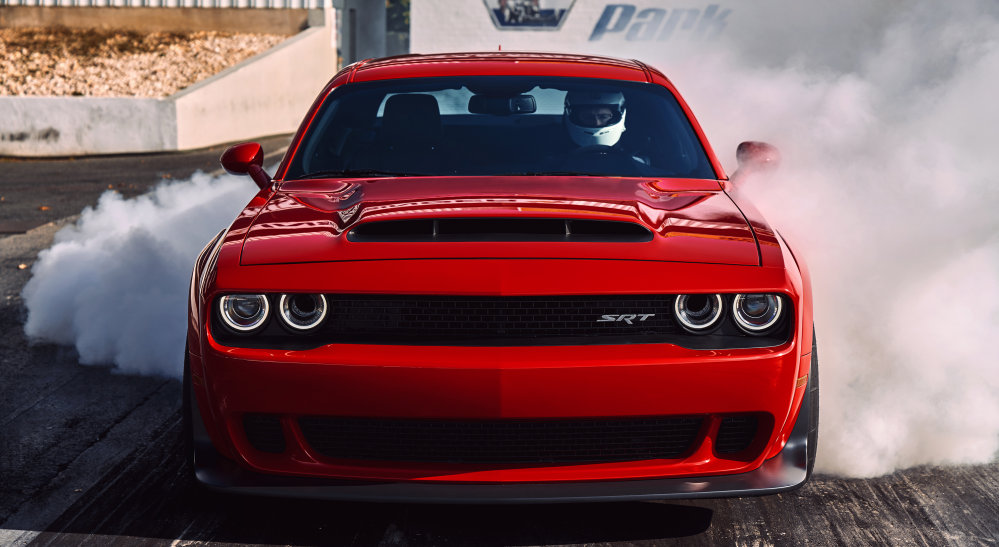
Mark Trostle explained that to make room for the intricate Air Grabber intake system, the entire underside of the hood is unique from the Challenger SRT Hellcat. Like the Hellcat, the Demon hood is made out of aluminum, but the inner reinforcements of the Demon hood are totally revised to handle the extra load from the new Air Grabber.
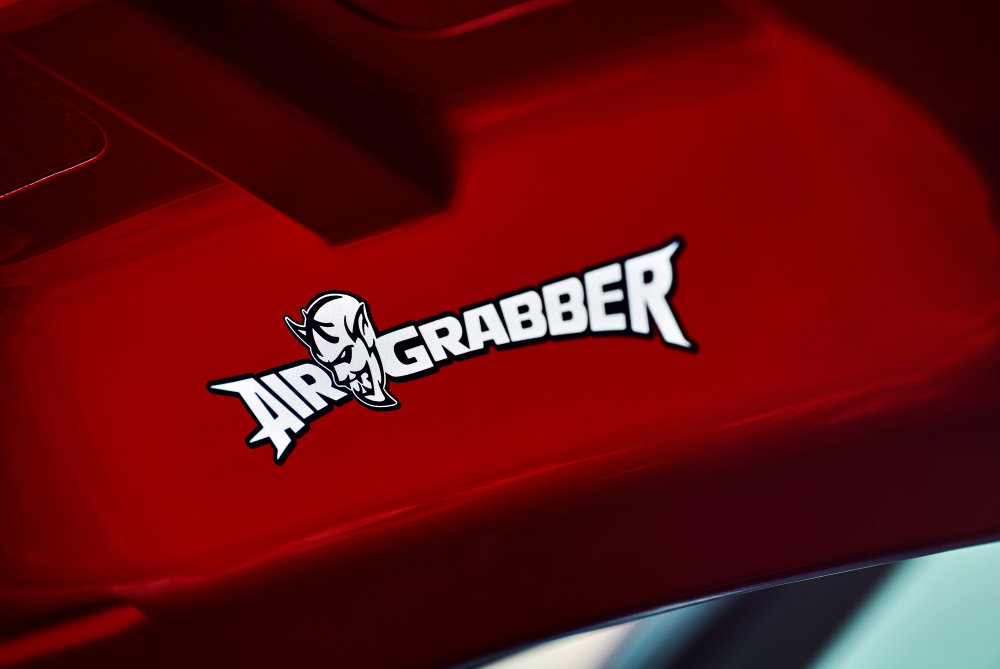
Also, while we were talking about the hood of the Demon, I asked why the design team didn’t include the Mopar hood pins. Mark Trostle explained that when designing the Demon, the team didn’t want to add anything that wasn’t absolutely necessary. While the Mopar hood pins look great, they aren’t required, and with the factory hood latch in place, there is no need to add those extra ounces to the newest Mopar muscle car.
Why Do the Front Runners Sit in So Far?
The 2018 Dodge Challenger SRT Demon comes with 315mm Nitto drag radial tires mounted on 18” lightweight wheels at all four corners, but it also comes with the Demon Crate, which includes the skinny “front runner” wheels. The flared front fenders were designed for the 315 tires up front, so when the skinny wheels and tires are bolted on, they sit way in from the wheel well edge. Some critics want to know why the company didn’t pick a front runner wheel with a larger offset that would allow them to better fill out the wheel openings.
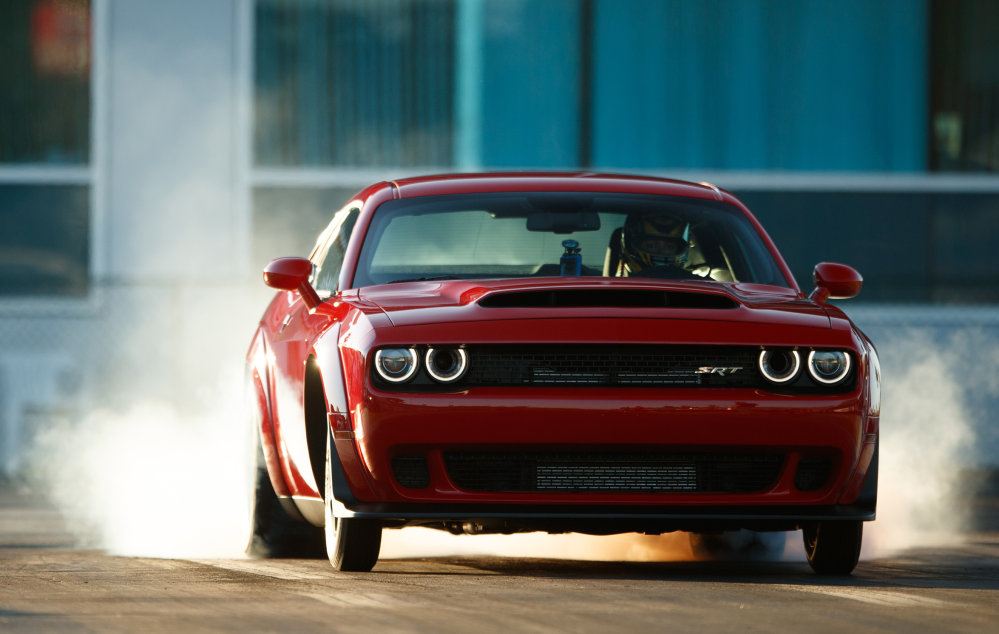
Mark Trostle explained that with these skinny front wheels, they put aesthetics aside to focus on function. Going to a front runner wheel with a larger offset might look nicer, but that greater offset would also add weight while negatively impacting top-end aerodynamics. For the sake of improved aerodynamics at higher speeds, and cutting every ounce possible, the team went with the front runners that sit tight against the chassis.
Rated for Big Speeds
The 2018 Dodge Challenger SRT Demon has an electronically limited top speed of 168 miles per hour because that is the maximum speed rating of the Nitto drag radial tires. Of course, if an owner removes the speed limiter, the Demon will almost certainly go well beyond 168 miles per hour, but owners won’t have to worry about the flares and hood being strong enough for those higher speeds. Those unique aerodynamic components are engineered to withstand the force of much greater forces than the car could possibly generate, even on a track much longer than a quarter mile, so those owners looking to run the Demon on the half-mile won’t have to worry about the structural integrity of the Demon-specific body parts.

However, anyone looking to spend much time north of 168 mph in the Demon will want to get tires that are rated for those greater speeds.
So, there you have it. The Dodge Challenger SRT Demon has flares because it needs them, and they are more than just component pieces stuck onto the standard Challenger sheet metal. The Demon front runner wheels are tight to the chassis for aerodynamic and weight advantages, the new Air Grabber hood is uniquely reinforced, and all of the Demon-specific body parts are good for speeds far beyond the electronically limited top speed of 168 miles per hour.
